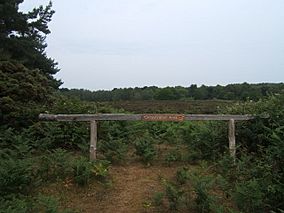North Warren RSPB reserve facts for kids
North Warren RSPB reserve is a special place in Suffolk, England, where nature is protected. It's looked after by the Royal Society for the Protection of Birds (RSPB). You can find it on the coast of Suffolk, near the towns of Aldeburgh and Thorpeness. It also includes an area called Aldringham Walks, which is a type of open land called heathland.
This reserve is part of a beautiful area called the Suffolk Coast and Heaths Area of Outstanding Natural Beauty (AONB) and the Suffolk Heritage Coast. North Warren is famous for its birds, like the Eurasian bittern and European nightjar. It has many different types of coastal homes for animals, like beaches and wetlands. Because it's so important, it has special protection status as a SSSI and a SPA.
Contents
What Makes North Warren Special?
North Warren RSPB reserve covers about 4.43 square kilometers (1.7 square miles). It has a mix of different natural areas, including:
- Grasslands
- Lowland heath (open land with small shrubs)
- Reed beds (areas with tall grasses)
- Shingle beaches (beaches made of small stones)
- Sand dunes
- Woodlands
Amazing Plants to Discover
On the shingle beaches, you can find rare plants. These include the sea pea, sea kale, sea holly, and yellow horned-poppy. These plants are special because they can grow in tough coastal conditions.
Birds You Might Spot
North Warren is a very important place for many bird species. Some of the key birds that live here include:
- The Eurasian bittern, a shy bird known for its loud "booming" call.
- The European nightjar, which hunts insects at night.
- The nightingale, famous for its beautiful song.
- The western marsh harrier, a large bird of prey.
It's also a vital spot for wildfowl (water birds) during winter. You can see many Eurasian wigeon and common teal. A flock of greater white-fronted geese also spends the winter here. In 2007, seven nightjars and 23 pairs of woodlark were recorded.
Mammals, Reptiles, and Amphibians
Many different animals call North Warren home. You might see mammals like the European otter, European water vole, European badger, and European rabbit. Sometimes, red deer and muntjac (small deer) can also be spotted.
In the heath areas, you can find reptiles such as the adder (a type of snake), slow-worm (a legless lizard), and common lizard. In the wet areas, look for amphibians like the common frog, common toad, smooth newt, and palmate newt.
Insects and Butterflies
North Warren is buzzing with insect life, especially in summer. You'll see many different dragonfly and butterfly species. One very rare butterfly found here is the silver-studded blue.
In 2007, a new insect to the UK was found here for the first time. It was the wheat bug, Nysius huttoni. This insect came from New Zealand and feeds on weeds and crop plants. It has since spread to other places in the UK.
Protecting North Warren
North Warren has special protection because it's such an important natural area.
Why It's Protected
The reserve is part of the 'Leiston - Aldeburgh' Site of Special Scientific Interest (SSSI). This means it's a nationally important area for its wildlife and geology. Parts of the reserve are also included in the 'Sandlings' Special Protection Area (SPA). This is a European-level protection for birds. It also lies within the Suffolk Coast and Heaths Area of Outstanding Natural Beauty (AONB) and the Suffolk Heritage Coast. These areas are protected for their beautiful landscapes.
Visiting North Warren
North Warren is a great place to visit and explore nature.
How to Get There
You can reach North Warren from the road between Aldeburgh and Thorpeness. Bus service 64 travels between Aldeburgh and Saxmundham. The closest train station is in Saxmundham, about 6 kilometers (3.7 miles) away. The Suffolk Coast Cycle route also passes nearby. If you enjoy long walks, the Suffolk Coast Path and Sandlings Walk trails go through the reserve.
What to Expect When You Visit
The reserve is open all year round, and there is no entry fee. North Warren itself doesn't have extra facilities, but there's a pay-and-display car park nearby in Aldeburgh, along with public toilets.
The paths inside the reserve are not paved. This means they might be difficult for wheelchairs or buggies. However, you can still see many of the reed beds from a paved path next to the road. Dogs are generally not allowed on the reserve, except for assistance dogs. They are only allowed on the public rights of way that cross the reserve.
History of the Reserve
The RSPB first bought a part of North Warren in 1939. This first section was about 37 hectares (91 acres). They were interested in the birds that nested there. Over the years, the reserve has grown as more land became available. Today, it covers about 443 hectares (1,095 acres).
During World War II, the area was used as part of Britain's coastal defenses. Soldiers built pillboxes (small concrete bunkers) and trenches on the heath. They also placed tank traps across the marshes to stop enemy tanks.



